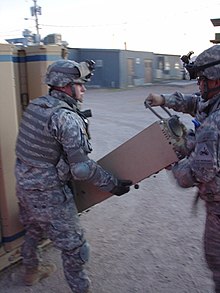XM501 Non Line of Sight Launch System
The XM501 Non Line of Sight Launch System (NLOS-LS) is a rocket launch box with 15 rockets that is being developed by NetFires LLC, a cooperation between Lockheed Martin and Raytheon . The system was to be used in the Army's Future Combat System, which has since been discontinued, and in the Navy's Littoral Combat Ships . Each container launch unit consists of 15 guided missiles and a data link. It is possible to link several containers together. The weapons are started remotely via the network and are around two meters high. The entire system can be transported on anything larger than a pick-up or as an external load on helicopters of the type UH-60 or more powerful models. Originally developed for the Future Combat Systems program, it was then transferred to the successor program Brigade Combat Team Modernization . The development was stopped in May 2010.
Container launch unit
The CLU can stand on ships, vehicles or simply in the landscape. The launch order and the target coordinates come via the network .
- Capacity: 15 guided missiles in launch shafts
- Weight: ~ 1,428 kg
- Can determine its own position autonomously
- Autonomous rocket launch
- Battery life: 72 hours
Guided missiles
Originally, two missiles should be used, the Precision Attack Munition (PAM) and the Loitering Attack Munition (LAM) . The LAM was supposed to be developed by Lockheed Martin Missiles and Fire Control but was stopped because of poor performance and skyrocketing costs.
Precision Attack Ammunition (PAM)
overview
The PAM should attack vehicles, tanks, bunkers and other ground targets with its multi-purpose warhead. It has three operating modes: flight to a GPS position, laser guidance (requires target lighting by other units) and self-targeting with an infrared viewfinder. To do this, the rocket has an image library to identify possible targets. The missile can also fly waypoints in order to avoid anti-aircraft positions during an attack.
Data
- Weight: approx. 60 kg
- Diameter: approx. 18 cm
- Steering: GPS / INS, imaging infrared, semi-active laser steering
- Data link: in-flight updates, reactivation, target images
- Propulsion: rocket motor with variable thrust
- Range: 40 kilometers
Loitering Attack Ammunition (LAM)
overview
Should fly to the target area and circle (loiter) and automatically discover and report targets or attack ( loitering weapon ).
Data
- Weight: approx. 60 kg
- Diameter: approx. 19 cm
- Steering: GPS / INS, laser radar (LADAR) with automatic target recognition
- Data link: in-flight updates, reactivation, target images
- Drive: jet drive
- Range: 70 kilometers with 30 minutes waiting time in a circular flight
Program status
- November 2002 - Precision Attack Missile's first flight
- December 2005 - Successful Loitering Attack Missile Boost Test Vehicle (BTV) flight test at Eglin Air Force Base, FL
- April 2007 - Successful test shot from a Precision Attack Missile from a CLU in the White Sands Missile Range
- June 2007 - Successful test shot of a Precision Attack Missile against a bunker
- End of 2008 - Start of production of operational systems for testing purposes in small numbers
- April 2010 - The military magazine "Jane's" reported that high-ranking representatives of the US Army had asked the Department of Defense to cancel the project. The reasons are poor results in tests of the new weapon and the high cost.
- May 2010 - Development stop
- January 2011 - Formal termination of the program





